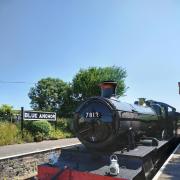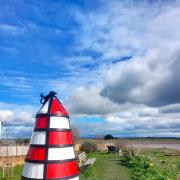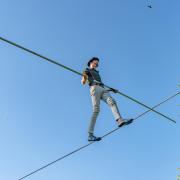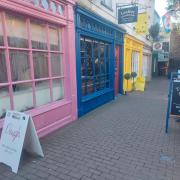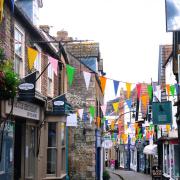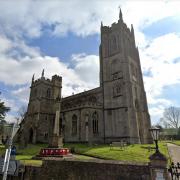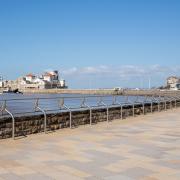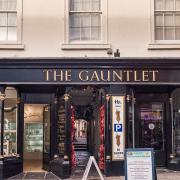Simone Stanbrook-Byrne takes a look at The Macmillan Way, a long-distance path that was specifically set up to raise money for charity

Walking, most will agree, is good for the soul. Fresh air and exercise in the great green gym of our beautiful countryside is hard to beat for ‘feel good’ results. And when it’s undertaken with the additional aim of raising money for charity, then that little fuzzy glow that is lit by a good walk burns even brighter.
Some people inspire by example, setting others off on worthwhile challenges upon which they would otherwise not have embarked. Peter and Janet Titchmarsh were two such inspiring individuals. Their decision to create one of the country’s long-distance paths and, in doing so, support the charity Macmillan Cancer Support, has resulted in more than £350,000 being raised as a direct result of the Macmillan Way network of footpaths.
Setting up a long-distance path is a marathon task: walking and describing the route, liaising with local authorities over signage, obtaining necessary permissions from Ordnance Survey with regard to mapping. It is a monumental amount of work. But Peter and Janet were undeterred. The Macmillan Way Association (MWA) was founded in 1997 and once they had established the main 290 mile Macmillan Way, from Boston in Lincolnshire to Abbotsbury in Dorset, they went on to set up further routes to augment the original. These include the Macmillan Way West which passes through Somerset and into Devon, linking with the main route at Castle Cary. Later, the Cross Britain Way was also added to the group, created by Tim Brunton and running between Boston and Barmouth on the Welsh coast.
In 2003, Jenny Davidson walked the main route, raising £6,000 in the process. This was the start of a new mission for Jenny who began assisting the Titchmarshes with the running of the association. Then, in 2009, when Peter was 82 and decided to hang up his long-distance boots, Jenny and her husband, Rod, took over running the MWA – and they’re still doing it, alongside their day jobs. An impressive undertaking and one that continues to inspire others. All power to their ankles!

The route:
The Macmillan Way group of paths has two sections in Somerset plus a ‘link’ between Langport, in Somerset, and Evershot, in Dorset, which joins the Macmillan Way West (MWW) with the main Macmillan Way. All are enticing, traversing varied countryside as well as visiting picturesque and historic villages and towns.
The main Macmillan Way enters the north of the county from Wiltshire, just south-east of Bath. It heads generally south, running for a while along the line of the River Frome, although not necessarily beside it. Further south it joins the Leland Trail.

The Way heads west through Bruton before reaching Castle Cary from which it continues south, joining for a while the Monarch’s Way, the route taken by Charles ll when he fled the country. It passes the hill fort of Cadbury Castle - it’s worth a wander round the ramparts. Excavations from 1890 onwards indicate that a Bronze Age settlement here was superseded by a more robust Iron Age fort, followed by later periods of settlement throughout a colourful history.
From here the main Macmillan Way traverses the fabulously airy Corton Ridge en route for Dorset.
Back at Castle Cary the MWW branches off on its 102 mile journey across Somerset and into Devon, a complete long-distance path in its own right.

A fitting start point is the red brick house in Castle Cary where Douglas Macmillan, founder of the Macmillan Cancer Support charity, lived during his early years. He was born in Castle Cary in 1884. When his father died from cancer in 1911 it left a lasting mark on Douglas. These were the days long before the NHS; care for sick people bore little resemblance to what we have today. In 1912 Douglas founded the Society for the Prevention and Relief of Cancer, starting with a donation of £10.
From Castle Cary the MWW makes its way generally westwards across South Somerset, passing many appealing places for walkers to take a break. Crossing the Somerset Levels the views are expansive – and potentially windy. Wildlife on the Levels is good: grey herons can be spotted and we once had a fabulous daytime view of a barn owl.
From Langport the MWW continues across the Levels, passing Burrow Mump, another detour-worthy spot. A breathy climb to the summit rewards with a glorious panorama. For a while the path runs alongside the River Parrett before continuing west towards the Quantocks where it starts to head slightly northish for a while. There are options on a high and low-level route here: the high one climbs Cothelstone Hill from which the views are tremendous but were probably not appreciated by the 17th century rebels of the Monmouth Rebellion, some of whom were hanged on Cothelstone.
Continuing through the Quantocks the high path passes the diminutive yet significant Triscombe Stone, a Bronze Age marker where old drovers’ roads meet. Just beyond here the high and low routes converge, the latter having passed through the village of Cothelstone.
The MWW continues, crossing the West Somerset Railway north of Stogumber, where it also runs concurrently for a while with the Coleridge Way, a path commemorating the poet Samuel Taylor Coleridge who once lived in the area. These paths separate at Sampford Brett where the MWW heads for Williton, the almost-halfway point. The journey continues through historic landscape approaching Dunster with its castle. From here the MWW offers an optional diversion to Minehead before heading into Exmoor, climbing the heights of Dunkery Beacon with its mighty cairn, the highest point of the moor. There is a very good chance of seeing Exmoor ponies hereabouts, our oldest native breed. Although they roam freely they are all owned and rounded up annually so that their wellbeing can be checked.
The MWW continues across the vast open spaces of Exmoor, crossing the boundary into Devon and for a while joining the Tarka Trail, a path that explores the country celebrated in Henry Williamson’s enduring book, ‘Tarka the Otter’. The walk continues through Devon, where it comes to a halt and removes its boots in Barnstaple.
Compass points:
Maps: As well as a selection of specific and detailed guide books and planners, the Macmillan Way website links to Ordnance Survey’s Map Shop through which you can buy the relevant OS map for the section you plan to walk. You can choose scales of 1:25 000 or 1: 50 000, bearing in mind that 1:25 000 gives much greater detail – this is what I prefer to use and would recommend. You could, of course, view the maps on your phone but this doesn’t give the full overview of surrounding areas provided by a proper map – even if it is wrapping itself round your ears in a high wind.
Walking the Macmillan Way:
The first port of call for information is the Macmillan Way website on which there is a heap of useful advice. Various publications are listed along with suggested accommodation stops and a selection of photos to whet your appetite and inspire: macmillanway.org.
If, like me, you enjoy walking unencumbered, walking holiday companies will organise accommodation and luggage transfers for you, leaving you to self-guide during the day. This is a fabulous way to undertake a long walk, catching up with your luggage each night at a comfy B&B and recharging for the following day. Have a look at: westcounty-walking-holidays.com.
See also the website of the Long Distance Walkers Association: ldwa.org.uk.






